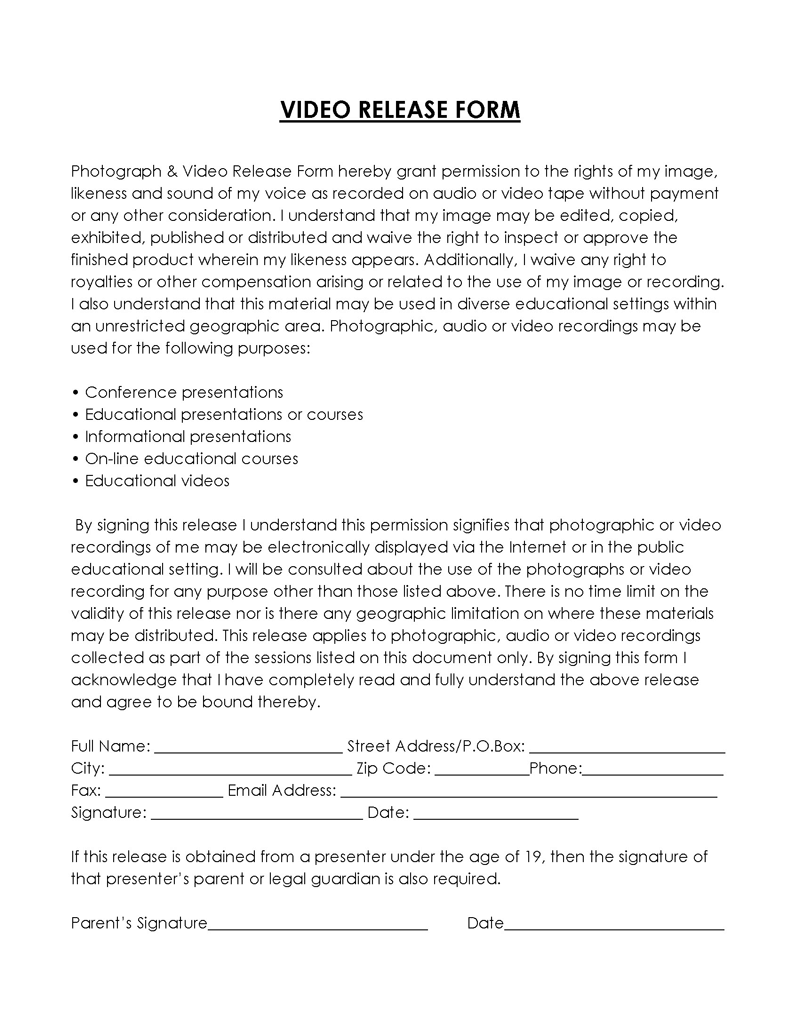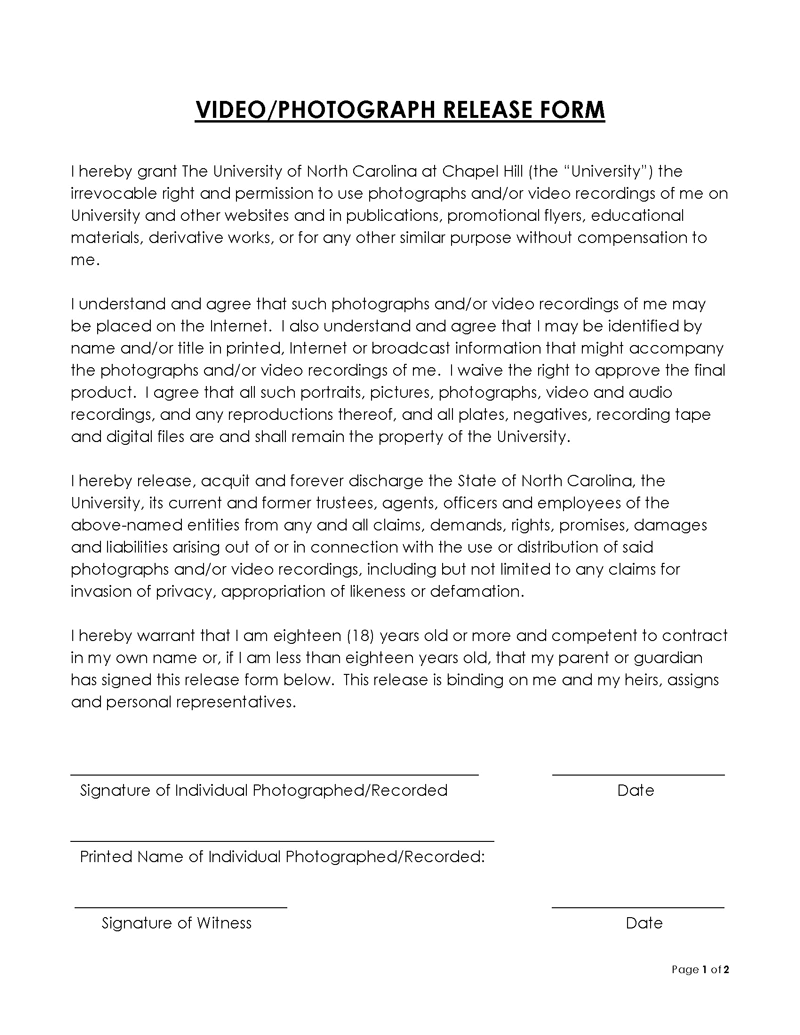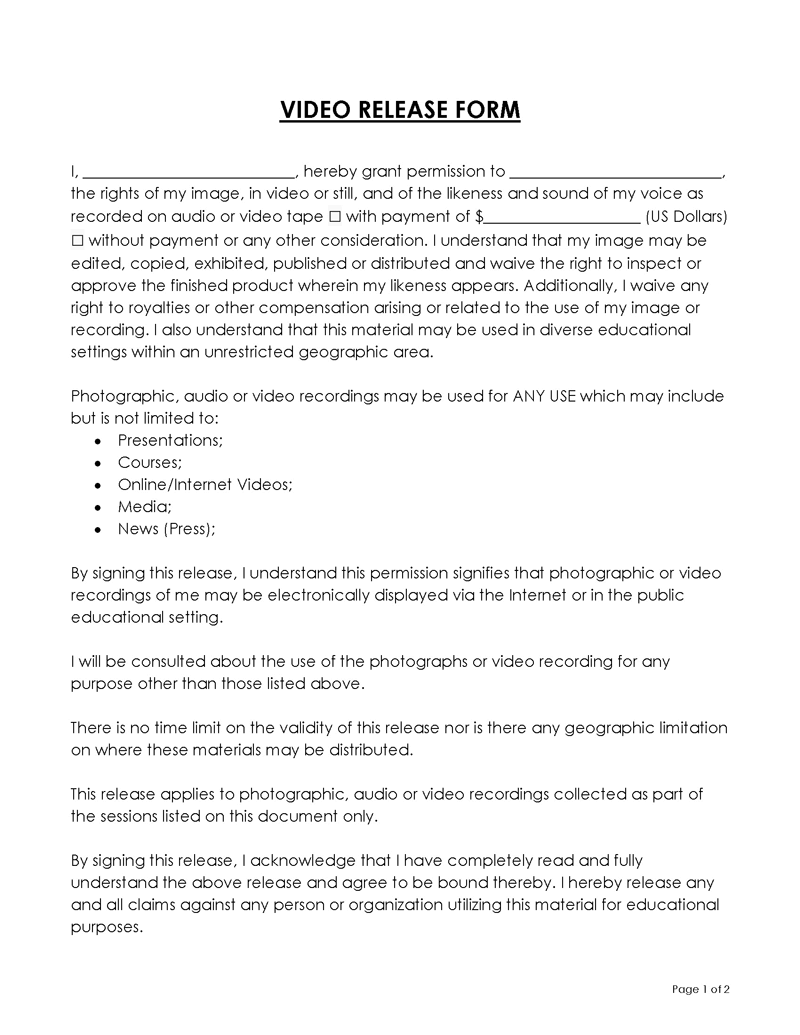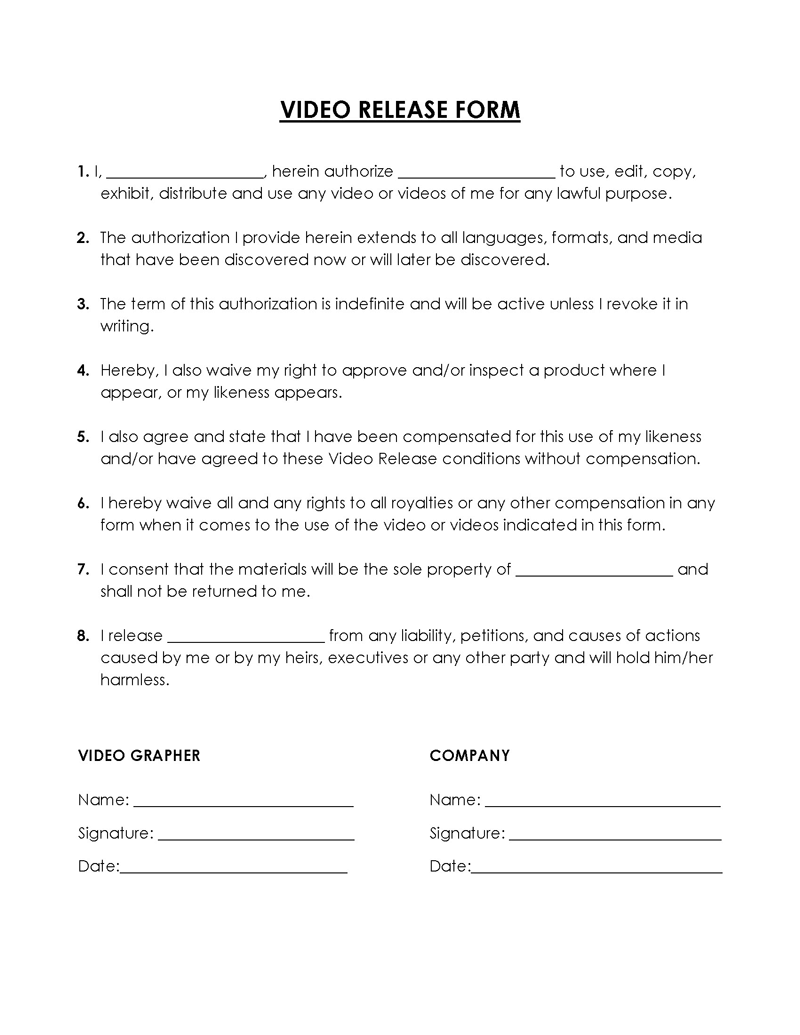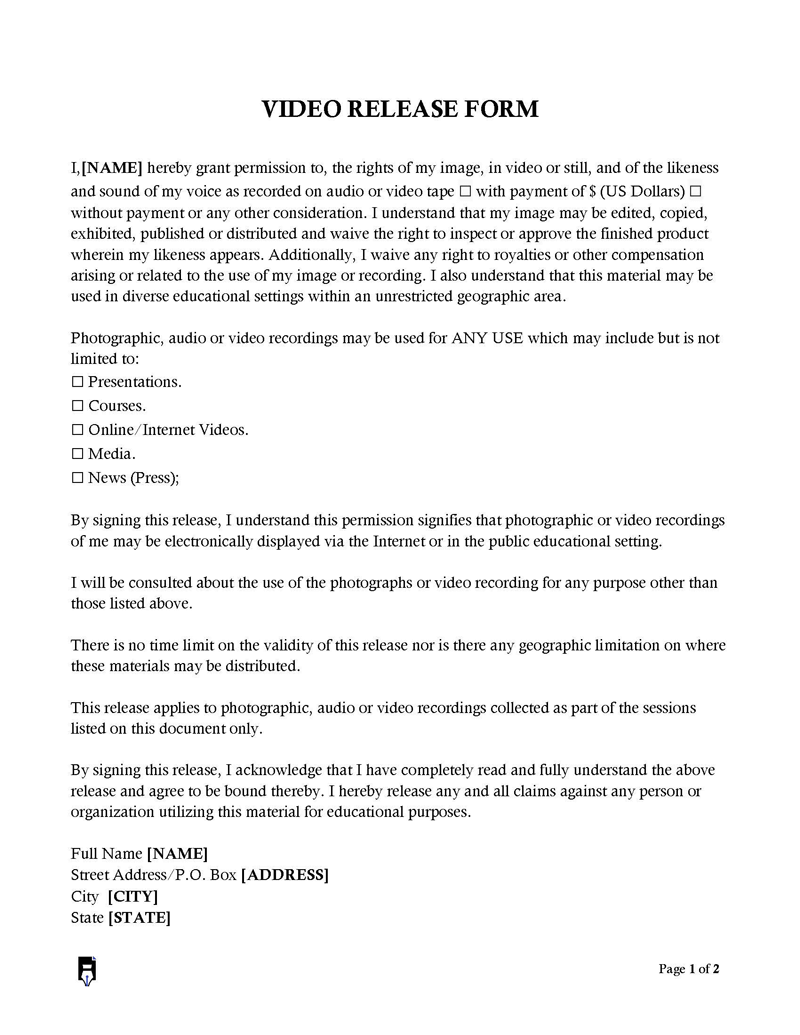When it comes to production, whether it is filmmaking, a documentary, or a journalistic interview, there are chances that you might feature people or certain places in your video. That is why you need to remember to use a video release form as a production company owner. In addition, to avoid any future complications with the subject, you must prepare this contract to obtain their consent.
They will have to sign the document for you to have the permission needed to use the said footage. Also, it is vital to not only attain permission from the subject of a video you want to use but also to protect yourself from any lawsuits that might arise from using the video and its form of media without permission.
Remember that using such footage with the proper permission for commercial benefits is illegal as it is considered a privacy invasion. In this article, you will learn what a video release form is, how to create one, what information you need to include in the contract, and why it is crucial to have it at every step of the production process.
Video Release Templates
Following is the video release form that you can download for free:
Video Release Form
A video release form is a legally binding document between you as the production company owner and a subject(s) whose voice and image you want to use for commercial purposes.
With this contract, you as the third party will be allowed to use the subject’s appearance both in video format and still image alongside their voice for your benefit.
Once the release form is signed, the subject will release their rights and transfer ownership of the footage (video) to you. You can use it for media, online, physical products (e.g., DVDs), or any other publication. Also, after the signature from the subject has been attained, you will not have to provide any other kind of compensation to them apart from what is mentioned in the contract.
Uses
Video release forms come in different shapes and sizes depending on the agreement and the type of project you are dealing with. You will need permission from your talents, that is, the interviewees, models, and actors so as to use their image (in video and photo form), audio, and voice. The common uses of a video release form include advertising, publication of newsletters, production of products like DVDs, courses, documentaries, movies, news (or press), online/internet videos such as YouTube, and presentations.
When and Why Do You Need a Release Form?
There are instances and reasons when and why you might need to use a release form, as shown below:
Why
You would need a video release form for many reasons, especially during production. You will need this contract to get a person’s permission to use footage with their appearance in terms of still images, video, and voice. This document also allows you to legally use the footage without risking lawsuits or any other legal complications in the future.
Another importance of using a release form, especially before beginning the production process, is that it prevents you from losses. This means, for instance, once you have conducted an interview, the interviewee will have no room to request the removal of their images and videos from your project. The form will permit you to use it.
When and when not a release form is required
Apart from the reasons why you need a video release form, you need to be aware of when and when not a release form is required. For example, you need it when you want to get permission from a subject to use a video that has its appearance for commercial use. Such subjects may include people, private property, trademarks, artwork, landmarks, logos, minors, and pets. If you have more than one subject, ensure each subject is mentioned in the release form.
However, you don’t need a release form when dealing with unidentifiable subjects or locations. You don’t need to use a video release form if you use the footage for your library or editorial. Also, you don’t need the contract when recording a generic meal where it is impossible to tell the owner. Ensure that the subject or location is unidentifiable beyond reasonable doubt.
Video Release Form
Since it is crucial for you as a production company owner to have a video release form during production, you need to know how to prepare one. The best thing to do is to access the form online and fill in the required information. Then, check out our free downloadable video release forms from our website to ensure you have a proper contract.
They are easy to access, free to download and provide proper built-in information to guide you when filling in the required details. Finally, use our free downloadable forms to prepare your video release form.
What should be Included in Video Release Form?
Below is the information that should be included in a video release form if you want to make your contract complete and adequate:
Forms of media
You will need to start by listing all forms of media you are going to use. For example, the media assets in a video release form include the video, still images, audio, and quotes created for future use. In the case of quotes, this mainly relates to an audio transcript prepared from an interview. Ensure you specify all these assets before the form is signed.
Third-party usage
You will also need to include a clause that allows you to either transfer or sell the rights and permission that the subject has given you to another third-party individual or company. The third-party usage clause is essential, especially since you are a production company owner in the business of producing things for commercial purposes.
Modification rights
The contract should also include language which states that you can modify the footage once granted permission. You will be able to edit and modify it to your liking. You can cut out some parts, add your style or even loop the audio. Whatever the case, ensure the correct language is used to give you the freedom to indulge in any modifications.
Commercial and non-commercial rights
The video release form should also include a clause concerning commercial and non-commercial rights. For non-commercial rights, do not intend to use the footage for promotional or financial purposes. This means the footage will be used for educational, artistic, or personal use.
On the other hand, commercial rights involve seeking permission to use the footage to promote, market, sell or benefit from monetary gains. Therefore, you need to include this clause as it will allow you to use the footage for commercial and non-commercial purposes. This is important, mainly if you aim to use the video for non-commercial purposes but decide to change the plan along the way.
To ensure you avoid such issues, ensure that you include a statement that gives you both commercial and non-commercial rights for current and future plans.
Time limit
Another essential aspect that should be included in the release form is time limit and expiration. Ensure that you mention the time during which the contract will be considered valid. Again, there are two options when it comes to include this information.
You might receive instructions from the subject to only use the video for a specific period. In other cases, such instructions might not be presented to you. That means you will need to indicate that you can continue using the mentioned media forms even if situations change in the future. This is done by indicating that your permission is indefinitely meant for current and future usage.
Future uses
When it comes to future uses, you need to indicate that the particular film you want to use is not meant only for current use but also for future purposes. In addition, you need to consider any future opportunities you might get to use that documentary or interview to avoid limiting yourself to current users only. Therefore, ensure you customize your contract to cover your present and future uses.
Payment
Finally, the last information you should include is the payment regarding using the video. Again, as the production company owner, you need to include details of the compensation you will pay the individual appearing in the video. In addition, you will need to specify whether this individual will be entitled to any payment.
This information must be included in the release form once an agreement has been made between you and the individual. In case the individual is not entitled to any payment, you should include the following clause, “The releasor hereby waives the right to any compensation, including but not limited to any royalties arising from the use of the videos.”
If the individual is entitled to compensation, you must indicate if the payment will include royalties, commissions, or any other form of compensation.
How Does a Video Release Form Work?
As a production company owner, you need to know more than just how to create this video release form. You also need to understand how it works.
Once the subject has signed the form, they will permit you to use the video.
Below are the three steps you will need to observe if you have a video release form that works:
Lookup for privacy laws
First, start by looking for privacy laws that require people to seek permission before using footage that contains identifiable appearances of individuals or specific property. This means you need to get everyone who appears on the said video to sign the form, as failure to do so may attract lawsuits your way or have the video pulled down after publication. With this form, you not only get permission to use the video but you can also use still images and even modify the video.
Obtaining permission from the client
The next step is to seek the client and obtain their consent to use the video. Again, it is about getting their permission to use the footage for commercial purposes. This contract acts as an enduring license, meaning you will be permitted to use the video for different purposes in the future. Also, you will be able to specify the payment arrangement between you and the subject(s).
Fill and sign the document
Finally, you will need to download the form, fill it and have it signed by the required parties. This contract is only complete and legally binding if it contains the names of the involved parties, contact information, addresses, and the date of the agreement. Alongside that, it should be signed by the relevant individuals so that you can now use the video in question.
How to Write a Video Release Form?
You can write a proper video release form during your production process with the following steps. Whether you are crafting your contract from scratch or using a template, you can use these steps:
Design/craft the form
Start by designing the form to fit the contract you want to prepare. Ensure your document has the required built-in details and blank spaces to fill in the required information.
Name of the recipient and the production company
Once you have crafted your form, start by filling in the recipient’s name and your production company’s name. The recipient is the individual who will allow their footage to be used for commercial purposes. Ensure that you include the complete and official name.
You need to include your production company’s legal name for easier identification. Ensure that you fill in your production company name where it indicates that you are the entity that is seeking the recipient’s permission to use the video.
Payment terms (paid/non-paid)
The next part is to include the payment terms. This includes whether the recipient will receive compensation for the video or not. In addition, the language should specify the kind of compensation (or lack thereof) the individual will receive once they release their rights over the video to you by signing the document.
For payment, indicate “With payment” and include the value in dollars; if there is not, indicate “Without Payment or Any Other Consideration.”
Recipient’s contact information and signatures
The final part of your contract to complete is to include the recipient’s contact details and their signature(s). This section should establish that the individual will have released their rights over the video to you by signing the document. At this point, you will need to indicate their complete mailing address (full name, street address/P.O. box, city, state, and zip code), followed by their phone number, fax number, and email address.
The recipient should then sign the document and provide the signature date. If it is a minor, the parent or guardian should sign on their behalf and provide a signature date.
Frequently Asked Questions
What’s the difference between a media release form and a video release form?
The difference between a media release form and a video release form is that while a media release form is meant to grant you authority over not just the video but also other media assets such as pictures, print, and the recorded sound of a subject, a video release form is a contract made to permit you only to use the video footage of a subject. However, these two terms are used interchangeably.
Do I need a video release form?
You need a video release form if you capture footage of an identifiable subject or place and are planning to use this footage for commercial purposes. This includes either selling or publishing the said footage.
Who owns the copyright of a video?
The videographer is the copyright owner of the video. However, it all depends on circumstances such as the licensing agreement, whether or not the videographer is employed for their skills or if the footage has been commissioned.
Can you publish footage of strangers?
Using a video release form, you cannot publish footage of strangers without getting their written and signed consent.
Do I need a video release form for minors?
You need a video release form for minors. Since that is the case, you must have a signed contract to use the video. However, since a release form is a legal document that people of legal age can only sign, that is, eighteen years old and above, you will have to get the contract signed by their guardian or parent.
When should a video consent form be signed?
There are several instances when you should get the relevant parties to sign a video consent form. First, ensure you get this form signed before you start recording a video. You would not want to spend so much money on a video and have the subject of the video forbid you from publishing it. Ensure that you explain the individual all about the form, as it will help convince them to sign the consent. For minors, ensure you ask their parent or guardian for the required signature.
